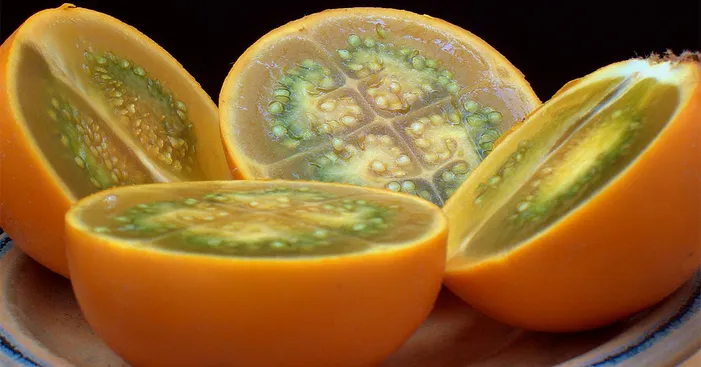Table of Contents
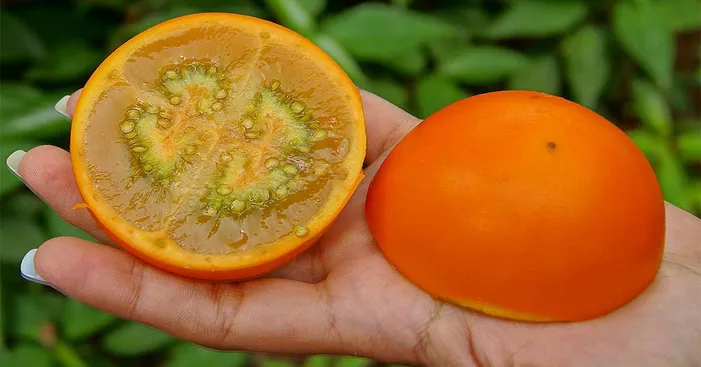
This vibrantly orange fruit with a shockingly green interior isn’t just a pretty face (well, it kind of is, with its fuzzy skin and sunshiney flesh).
It packs a powerhouse punch of vitamins, antioxidants, and other good-for-you goodies that will have your taste buds and your body doing a happy dance.
But wait, there’s more! Naranjilla isn’t just some trendy health fad.
This exotic fruit has been a treasured part of South American cultures for centuries, used in everything from refreshing juices to traditional dishes.
So, buckle up, amigos, because we’re about to take a deep dive into the world of naranjilla and unearth all its juicy benefits.
General facts about lulo fruit:
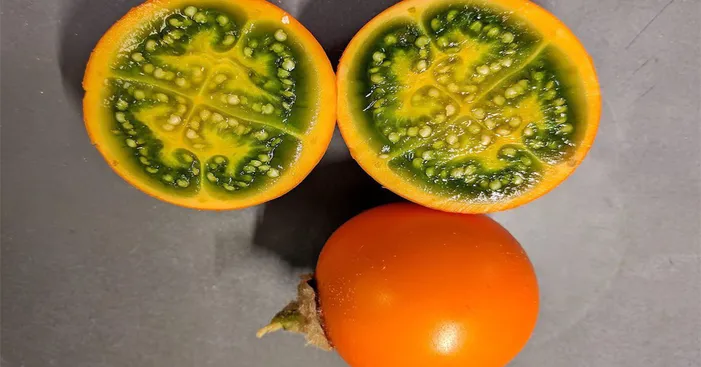
Overview:
Nestled in the heart of the inter-Andean region, from southern Colombia to Ecuador and Peru, lies a fruit with a captivating story.
Known to the Incas as “lulo fruit,” meaning “little orange,” for its resemblance to the citrus giant, this fruit also boasts the charming name “lulo” or “lulum.”
Its exquisite taste, a delightful dance of sweet and tart, is a treasure for those who appreciate a touch of tang in their sunshine.
While its roots lie in the Andean valleys, recent years have seen the lulo embark on a journey beyond its birthplace, gracing the shelves of supermarkets in Costa Rica and other countries eager to embrace exotic flavors.
So, if you’re seeking a taste of adventure, keep an eye out for this vibrant orange orb – it’s a bit of the Andes waiting to be discovered.
History:
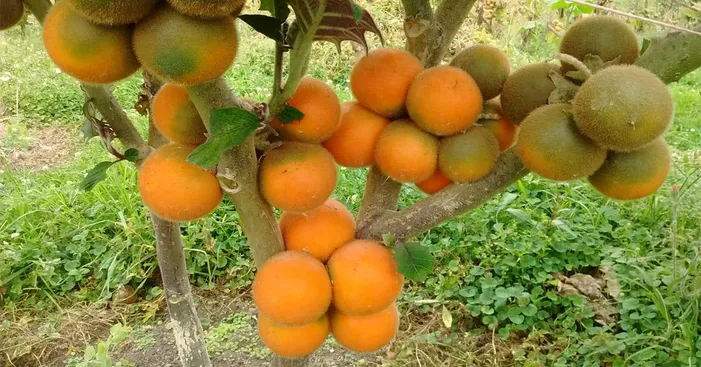
The lulo fruit, a fruit with a confusing ancestry, may have emerged from the misty mountains of Colombia and Ecuador sometime in the 17th century.
Locals there call it “lulo,” echoing the Inca’s affectionate “lulum,” hinting at their appreciation for its juicy embrace.
Over time, this vibrant adventurer made its way through South and Central America, finding new homes in Peru, Panama, Guatemala, and Costa Rica.
However, its delicate soul proved challenging to cultivate far from its birthplace.
Despite a triumphant debut at the 1939 New York World’s Fair, lulo fruit’s international ambitions remained unfulfilled.
Its finicky nature and stubborn refusal to bear fruit beyond South America kept it a regional treasure.
Even giants like Campbell’s Soup stumbled in their attempts to capture its essence, their processed versions deemed unworthy substitutes for the real deal.
So, the lulo fruit continues to bask in the sun-drenched slopes of its native lands, a vibrant testament to the beauty of local bounty.
Lulo fruit nutritional values and health benefits:
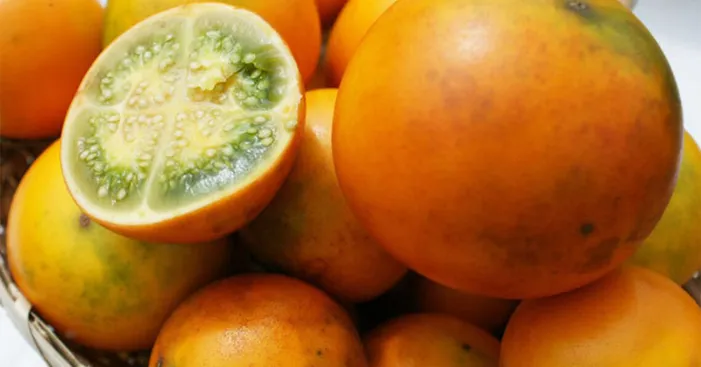
Nutritional values:
The lulo fruit is edible. It can be eaten raw, for example in salads, or used to make desserts, fruit juices, or smoothies.
Its nutritional value per 100 grams is as follows:
- Calories: 25
- Water: 87%.
- Carbohydrates: 8 grams
- Protein: 0.74 grams
- Fat: 0.17 grams
- Fiber: 2.6 grams
- Vitamin A: 568 IU
- Vitamin C: 29.4 milligrams
- Calcium: 34.2 milligrams
- Iron: 1.19 milligrams
- Sodium: 2 milligrams
Health benefits:Nature’s Immunity Elixir:
Packed with Vitamins C and A, lulo fruit acts as a shield against invaders.
Vitamin C, the antioxidant warrior, scavenges free radicals while boosting white blood cell production, your body’s frontline defenders.
Digestive Delight:
Forget the tummy blues!
Lulo fruit’s secret weapon is pepsin, a fiber superstar that eases digestion, banishing constipation, cramps, and bloating.
It may even offer protection against more serious gut troubles like ulcers.
Eyes on the Prize:
Sharpen your vision with lulo fruit’s vibrant carotenoids, including Vitamin A and beta-carotene.
These warriors neutralize free radicals in your eyes, shielding your precious macula from macular degeneration, cataracts, and other age-related woes.
Cholesterol Conqueror:
Lulo fruit’s double punch of fiber and diverse vitamins and minerals is a boon for your heart.
This dynamic duo helps flush out harmful LDL cholesterol, reducing the risk of atherosclerosis, those stubborn, artery-clogging deposits, and lowering your chances of heart attacks and strokes.
Circulation Champion:
Get your blood flowing!
Lulo fruit’s fiber army sweeps away LDL cholesterol, while its vitamin and mineral treasure trove strengthens your cardiovascular system, minimizing the risk of arteriosclerosis, strokes, and heart attacks.
Building Bone Fortresses:
Strong bones are essential for a vibrant life, and lulo fruit, brimming with calcium, phosphorus, and iron, is your bone-building ally.
It fortifies bone tissue, protecting you from osteoporosis and even arthritis.
Detox Dynamo:
Lulo fruit, a traditional detox hero, acts as a natural diuretic, flushing out excess toxins from your kidneys, taking pressure off your liver, and eliminating unwanted salt, water, and even fat.
Stress Slayer:
Life’s demands can take a toll, but lulo fruit may offer a helping hand.
Research suggests it might influence hormone levels, potentially improving mood, reducing stress, and even promoting restful sleep for those battling insomnia.
Cancer-Fighting Candidate:
Early studies hint at a potential weapon within lulo fruit.
Methanolic extracts from the fruit have shown promise in inhibiting tumor growth.
Skin Savior:
Vitamin C, a key player in collagen production, is another treasure found in lulo fruit.
Collagen keeps your skin elastic and smooth, supporting healthy connective tissue, blood vessels, and even organs.
Other health benefits:
- Combats nervous disorders.
- Works against flu.
- Strengthens the immune system.
- Strengthens hair, nails, and bones.
- Helps reduce cholesterol.
- Prevents hypertension and migraine.
- The fibers it contains help facilitate digestion and improve intestinal transit, thus preventing constipation.
- Acts as a powerful antioxidant.
- Keeps skin smooth and healthy.
Precautions before you consume lulo fruit:

While vibrant and delicious, lulo fruits harbor a hidden secret: steroidal alkaloids like solanidine and tomatidine.
In high doses, these compounds can take a negative turn, potentially causing nausea, vomiting, dizziness, and indigestion.
But before you give up on your favorite salad, fear not!
The bitter edge resides primarily in the skin, so a simple peel reveals the harmless, juicy flesh beneath.
Remember, these pesky alkaloids have a mischievous streak, thriving in light and humidity, where their levels can quadruple like clockwork.
This fruit is part of the Solanaceae family which boasts culinary superstars like potatoes, tomatoes, peppers, and eggplants.
Hidden amongst these familiar faces lurk nightshade relatives, like lulo, adorned with prickly defenses and harboring potentially toxic alkaloids.
So, while indulging in this juicy fruit, remember – the Solanaceae family is a fascinating tapestry of food and folly, with each bite potentially a tale of two sides.
Using lulo fruit:
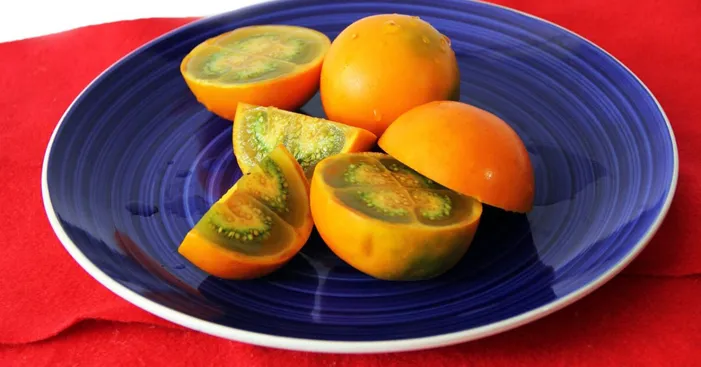
The versatility of lulo fruit shines brightest in its liquid forms.
This vibrant fruit takes center stage in lulada, a Colombian staple blending lulo fruit’s zing with refreshing water and a touch of sugar.
Whether simmered into jewel-toned jellies or jams, its sweetness adds a vibrant touch.
In savory pursuits, it can lend a surprising depth to meat sauces, while in vinaigrettes, its tangy edge dances with herbs and oils.
For a more complex symphony of flavors, try champús, where lulo fruit joins forces with pineapple, corn, warm spices, and citrus leaves in a vibrant concoction.
But Lulo fruit’s talents extend beyond the glass.
The fruit’s fleshy interior reveals a tart treasure trove.
Enjoy it raw for a burst of citrusy goodness, or transform it into delightful jams, jellies, and cakes.
Its unique character even elevates ice creams and desserts, while lending its tangy magic to juices and wines.
And don’t forget the finishing touch!
Lulo fruit makes a perfect garnish, brightening up ice creams, cakes, fruit salads, and even yogurts with its sun-kissed charm.
even the littlest gourmands can delight in its gentle sweetness, making it a perfect ingredient for baby food, where its playful mix of sweet and sour notes introduces them to a world of exciting flavors.
With such versatility, this fruit is a chef’s dream, ready to transform humble meals into culinary adventures.
Luminous Lulo Panna Cotta
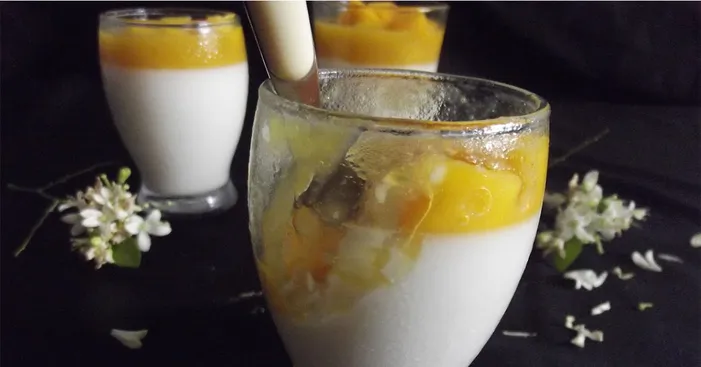
Impress your guests with this vibrantly hued dessert, featuring the unique tang of the lúlo fruit.
Its sweet and creamy panna cotta base provides the perfect canvas for a refreshing lúlo coulis, creating a flavor combination that’s both familiar and exotic.
Ingredients:
- 4 cups full-fat cream (heavy cream or double cream).
- 4-5 sheets of unflavored gelatin.
- 4-5 tablespoons of sugar, divided.
- 5 lulos (naranjillas).
Preparation:
- Begin by soaking the gelatin leaves in a bowl of cold water for about 5 minutes.
They should soften and become pliable. - Pour the full-fat cream into a saucepan and heat gently over low heat for approximately 20 minutes.
Stir occasionally to prevent scorching. - Once the cream is warm, add 5 tablespoons of sugar and continue stirring until fully dissolved.
This will form the base of your panna cotta. - Remove the saucepan from the heat and gently whisk in the softened gelatin leaves until fully incorporated.
Ensure they have melted completely. - Divide the panna cotta mixture evenly among 6 verrines or small glasses, filling them about 3/4 of the way.
Refrigerate for at least 3 hours, allowing the panna cotta to set completely. - As your panna cotta chills, prepare the lúlo coulis.
Peel the lúlos and coarsely chop the flesh. In a blender, combine the lúlo with the remaining 6 tablespoons of sugar and blend until smooth and vibrant. - One hour before serving, gently spoon the lúlo coulis onto the set panna cotta, filling the remaining space in the verrines.
Return to the refrigerator for an additional 30 minutes to allow the coulis to set slightly. - When ready, unleash the sunshine!
Your lúlo panna cotta is ready to be enjoyed.
Garnish with a sprig of mint or a sprinkle of toasted coconut for an extra touch of tropical delight.
Buying lulo fruit:
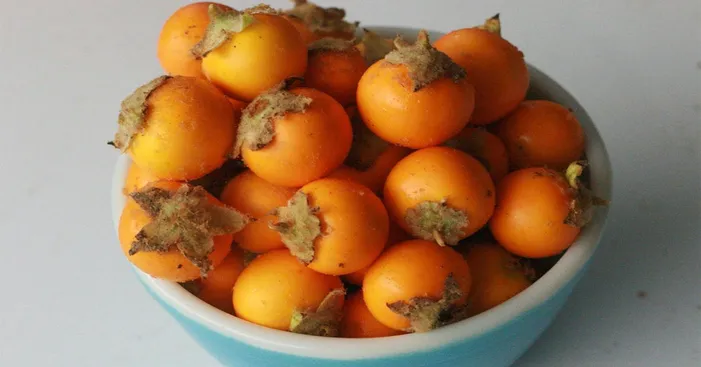
This round fruit glows with a vibrant orange once it reaches peak ripeness.
Peeling back its thin, surprisingly tough skin reveals a vibrant green surprise – the juicy pulp within.
Take a bite and you’ll be met with a refreshing burst of slightly tangy flavor, a delicious contrast to the sun-kissed exterior.
It’s a unique experience that promises to tantalize your taste buds and wake up your senses.
Therefore when you decide to buy lulo fruit here’s what you need to look for:
- Thin skin but hard.
- Green pulp.
- Perfectly round fruit with a bright orange color which indicates ripeness.
Storing lulo fruit:
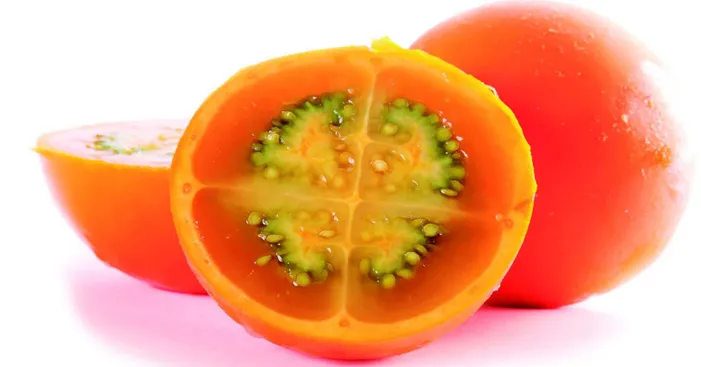
The fate of your lulo fruits depends on your timeline.
For impatient gourmands eager to dive into their tangy goodness within a few days, a simple plastic bag stored in a cool, dark corner will suffice.
Just like a cloak shielding a secret, keep them away from prying sunlight.
But for those seeking a longer reprieve, the crisper drawer in your fridge beckons.
Its cool embrace will extend its shelf life, keeping it plump and vibrant until your taste buds crave its citrusy burst.
So, whether you’re a speedy lulo fruit enthusiast or a patient connoisseur, the key lies in understanding their sun-shy nature and choosing the ideal haven for their temporary slumber.

